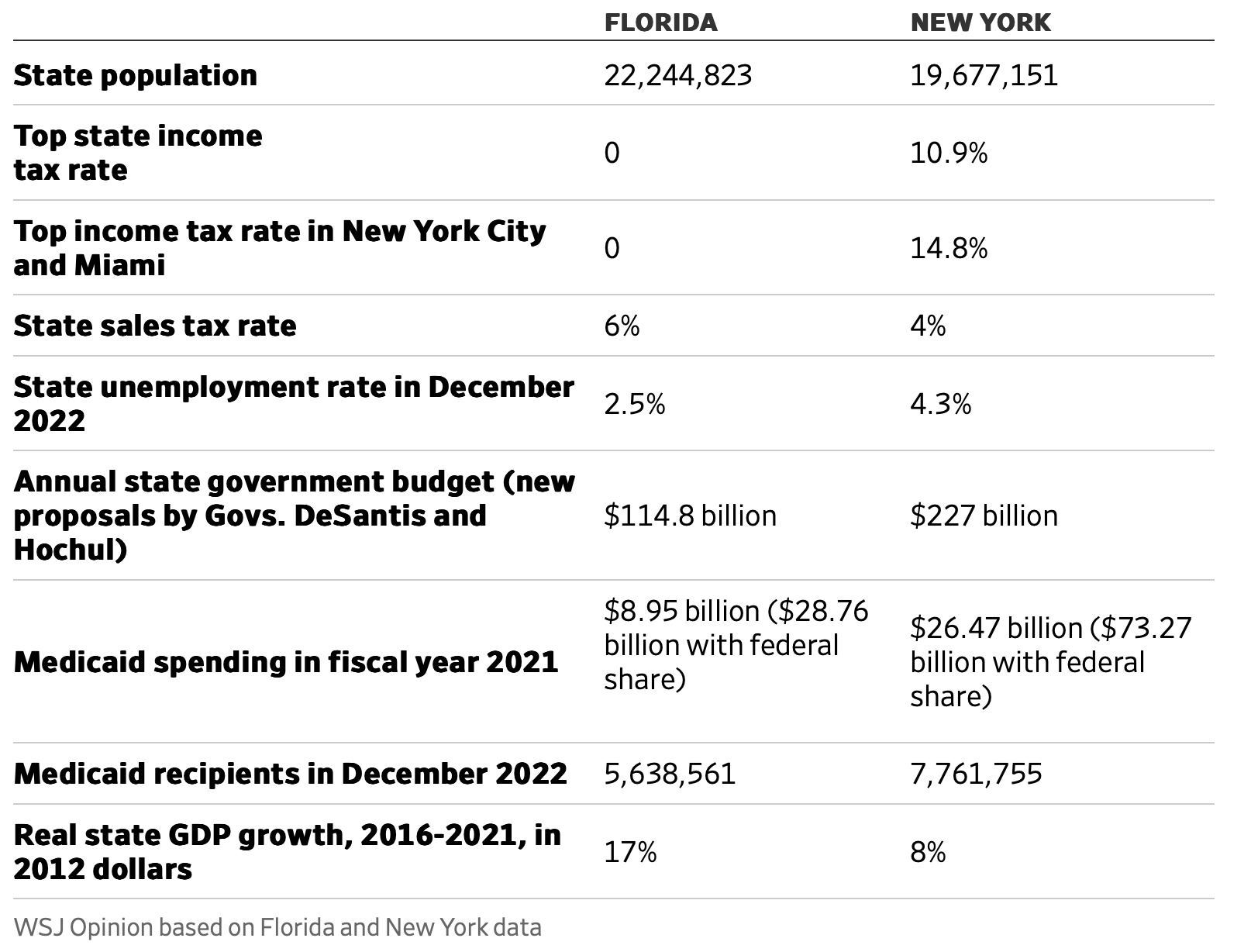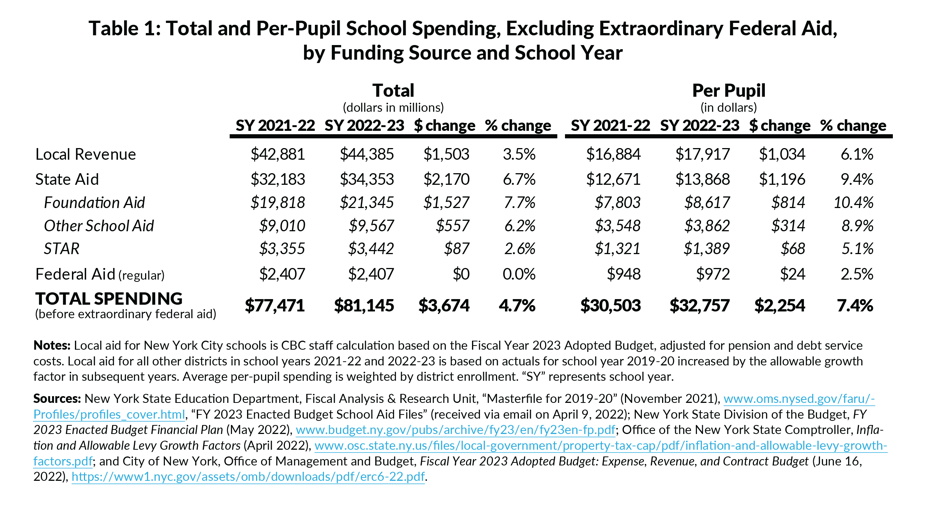Once Again, State Budget Time in New York And Florida
/It is gratifying to see a few other commentators starting to notice the dramatic contrasts between New York and Florida in government spending and policy outcomes. Here at Manhattan Contrarian, I first covered the subject in December 2020, with a post titled “Contrast Between New York And Florida.” I followed that up with reviews of the respective state budgets in April 2021 (“State Budget Time In New York And Florida”).
And now others are weighing in. The Wall Street Journal had a lead editorial on the subject on February 9, with the headline “New York vs. Florida, By the Numbers.” At Power Line on February 10, John Hinderaker highlighted and commented on some of the WSJ’s numbers.
You may already be aware of the truly incredible difference in state government spending between New York and Florida. But what you may not be aware of is the shocking lack of measurable benefit that New Yorkers get for all their extra spending. We congratulate ourselves on our superior moral goodness for supporting far higher spending to provide common government services to our lower-income residents in areas like healthcare, education, and housing. But when you comb the statistics to look for any results from the extra spending, you literally can’t find anything at all. In other words, all the extra spending is wasted.
Here is a chart of some relevant metrics that appeared in the WSJ February 9 editorial:
The contrast between the two state budgets leaps off the page. New York’s Governor proposes to spend $227 billion in the coming fiscal year, just about exactly double the Florida Governor’s proposed $114.8 billion of spending. But Florida has more than 13% more population. Thus, on a per capita basis, New York’s spending is 2.24 times higher. And by the time the respective legislatures are finished with the process, the contrast will certainly have become even worse for New York, since our progressive-dominated legislature is very likely to add significantly to the Governor’s spending proposals, while Florida’s Republican-controlled legislature may even cut the Governor’s proposed budget.
But surely we must get something for all that extra spending. Let’s look at a couple of the key areas.
Medicaid Spending
Medicaid is the single biggest area of New York’s wild overspending. From the WSJ’s table, you can see that New York spends nearly triple in state funds what Florida spends on the program ($26.47 billion versus $8.95 billion). Adjusting for population, New York’s spending is 3.35 times as high.
Actually, it’s even worse than that. Unique among the states, New York imposes a substantial part of its state share of Medicaid spending on county governments (including New York City). According to the Empire Center here, the amount of Medicaid spending that New York imposed on its counties in fiscal 2022 was $8.0 billion, which spending is not included in the WSJ chart. By contrast, according to this Report from myflorida.com from 2019, Florida drew less than $1 billion per year from its localities toward the state share of Medicaid. With that adjustment (not reflected in the state budget), New York taxpayers pay almost four and a half times as much per capita for Medicaid as Florida taxpayers.
The theory here has to be that the extra spending improves the health outcomes of New York’s poor and other low-income residents. How can we measure that? Healthcare outcomes are largely subjective and often not subject to definitive metrics. But one thing that can be measured and directly compared is life expectancy. Surely, for almost 4.5 times the per capita state Medicaid spending as Florida, and with almost 40% of the population participating in the Medicaid program, New Yorkers must have demonstrably longer life expectancy than Floridians.
In January 2023 the online pharmacy Nice RX came out with a study of life expectancy by state, using CDC data for the year 2020. And the results are: New York 77.7 years; Florida 77.5 years. It’s an almost imperceptible difference. This is beyond embarrassing.
K-12 Education
The best that can be said for New York’s spending on K-12 education is that it is not quite as out of line as its spending on Medicaid. But it is close. And again, for all the extra spending, New York achieves exactly nothing.
It can be difficult to get precise numbers for per student K-12 education spending as numbers of students fluctuate; but all sources agree that New York’s per student spending is well more than double that of Florida. (These figures include both state and local shares.). For example, World Population Review has a chart of 2023 per student K-12 education spending by state, which puts New York first at $24,040 per student, and Florida way down the list $9,346. But New York’s Citizens Budget Commission (an independent organization) does its own analysis of New York’s school spending, and finds several pockets of additional aid that others seem to miss. In an October 2022 Report titled “More Money, Less Accountability,” the CBC comes up with a chart that includes all the extras, and shows per student New York State school spending for the 2022-23 year to be $32,757. Here is the CBC’s chart, complete with links to sources:
Note that the total of three different categories of “State Aid” comes to $13,868 per student, before even getting to local share, or the (relatively modest) federal contribution. Another chart in the same CBC Report puts New York City per student spending in the 2022-23 school year at about $38,000. Meanwhile, Governor Hochul proposes an increase in state funding of 7.2% for the coming school year — even though the number of students is declining.
Meanwhile, according to this February 1 release from the Florida Department of Education, Florida’s Governor is proposing a state school aid increase in per student funding of just 2.5%, to $8,453 per year. (This figure does not include the local share.)
The best place to get data on student performance by state is from the NAEP tests, administered by the Federal Department of Education. The most recent tests were given in early 2022. Here are the results for Florida and New York:
Grade 4 Mathematics: Florida 241 (fourth highest among states); New York 227 (46th highest). The national average was 235.
Grade 8 Mathematics: New York 274 (23rd highest), Florida 271 (32nd highest). The national average was 273.
Grade 4 Reading: Florida 225 (third highest), New York 214 (36th highest). The national average was 216.
Grade 8 Reading: New York 262 (13th highest), Florida 260 (21st highest). The national average was 259.
The summary is that Florida students did substantially better in two categories, New York students better in one category, and the fourth category was essentially a tie. For this, New York pays double and more what Florida pays? Again, it is shocking.
And dare I mention that, with the far lower spending, Florida gets along just fine without any income tax at all? All I can say is, it’s no wonder that Florida continues to grow its population rapidly, while New York shrinks.

